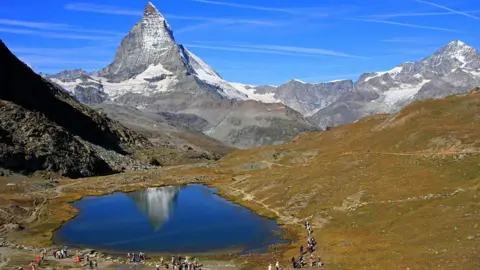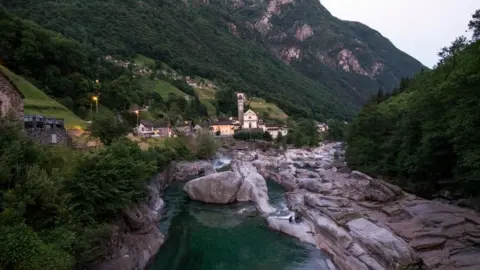 Andia/Universal Images Group
Andia/Universal Images GroupOne of Switzerland’s most stunning spots has become the latest to try to limit tourist access, in a bid to protect the environment from becoming overrun by Instagrammers.
Above the famous resort of Zermatt, the Riffelsee lake is more than picture perfect. Not only can you see the iconic Matterhorn in all its glory, you can capture its reflection in the glacial waters of the lake.
In high season, the rack railway takes thousands of tourists up there every single day, all of them intent on the ultimate shot.
And in June and July, when spring finally arrives in the high Alps, tourists can also see the alpine flowers that thrive up there at 2,800m (9,200ft): edelweiss, gentian, and alpine golden primrose.
At least they could.
But now the hordes of tourists disgorged by the railway every few minutes are taking their toll, tramping across the pastures towards the lake and crushing the flowers.
Edelweiss has not been seen around the Riffelsee for some years.
The Zermatt authorities have decided enough is enough.
Tourists can still come, but now they are shepherded towards the lake on marked paths, with the pastures fenced off.
The aim is not to deter visitors – after all Zermatt’s tourist office advertises the Riffelsee as a photo opportunity on its website – but to educate them about the alpine environment.
Inside the fences an alpine garden – Europe’s highest – has been created; narrow walkways allow visitors to take a closer look at the flowers, with QR codes explaining what they are.
It’s a fascinating glimpse of the biodiversity of the high Alps. Planning the garden, botanists found 148 different plant species.
Many tourists clearly appreciate it, taking time to examine the garden. Others though stream on by towards the lake, their selfie sticks aloft.
Zermatt’s problem is shared by other famous, or uniquely beautiful, parts of Europe.
In Florence there was fury after a tourist posted pictures of herself miming a lewd act with the Roman statue of Bacchus.
The beautiful southern Swiss village of Lavertezzo, famous for the emerald waters of the Verzasca river running through it, was overrun with cars, visitors, and litter after a video comparing it to the Maldives was posted on Facebook.
Meanwhile in the east of the country, Canton Glarus has witnessed a surge of wild campers, driven by Instagram, looking for clickable high mountain shots.
 Giovanni Mereghetti/UCG/Universal Images Group
Giovanni Mereghetti/UCG/Universal Images GroupIt’s dangerous for them, because many are not experienced hikers or climbers, but it’s worse for the alpine flora and fauna. The tents crush the pastures, the campers leave rubbish and human waste behind them.
Switzerland’s economy does very well out of tourism, but now some Swiss are asking if there can be too much.
Tourist offices report that the only question many visitors ask is “where is the best photo opportunity?”
It is disappointing for locals to realise that tourists might not really be coming to experience the beauty and culture their region has to offer, but to get more likes and shares on social media.
But Zermatt’s compromise with the alpine garden may be the right solution. The edelweiss has been replanted and, perhaps, next spring, its small white flowers will look happy to meet the next batch of tourists.
